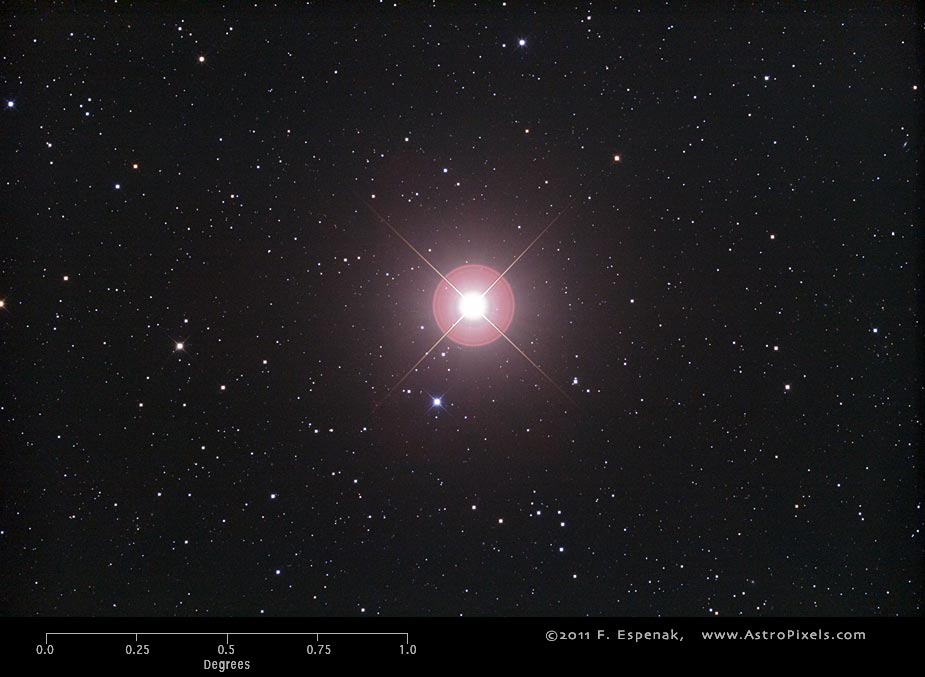Arcturus
Arcturus or Alpha Bootis (Alp Boo) is the brightest naked eye star in the constellation Bootes. With an apparent magnitude of -0.05v, Arcturus is the 4th brightest star in the entire sky (see: 50 Brightest Stars ). Its absolute magnitude is -0.31 and its distance is 36.7 light years. The Equinox J2000 equatorial coordinates are RA = 14h 15m 39.7s, Dec = +19° 10' 57".
Arcturus has a spectral type of K2III, a surface temperature of 4300° Kelvin and a luminosity 170 times the Sun. It has a mass of 1.1 solar masses and a diameter 26 times the Sun.
The image above shows the uncropped view of Arcturus (North is up) through the Takahashi E-180 Astrograph.
Arcturus is visible from both hemispheres in the sky, as it is located less than 20 degrees north of the celestial equator. The star culminates at midnight on about April 30th, being visible during the northern spring or the southern autumn. From the northern hemisphere, an easy way to find Arcturus is to follow the arc of the handle of the Big Dipper. By continuing in this path, one can find Spica, "Arc to Arcturus, then speed to Spica." The star is also a member of the Local Interstellar Cloud.
Arcturus is a type K2 IIIpe orange giant star-the letters "pe" stand for "peculiar emission," which indicates that the spectrum of light given off by the star is unusual and full of emission lines. This not too uncommon in red giants, but Arcturus has a particularly strong case of the phenomenon. It is at least 110 times visually more luminous than the Sun, but this underestimates its strength as much of the "light" it gives off is in the infrared; total (bolometric) power output is about 180 times that of the Sun. The lower output in visible light is due to a lower efficacy as the star is cooler than the Sun.
Arcturus is notable for its high proper motion, larger than any first magnitude star in the stellar neighborhood other than Alpha Centauri. It is moving rapidly (122 km/s) relative to the Solar System, and is now almost at its closest point to the Sun. Closest approach will happen in about 4000 years, when the star will be a few hundredths of a light year closer to Earth than it is today. Arcturus is thought to be an old disk star, and appears to be moving with a group of 52 other such stars, known as the Arcturus stream. Its mass is hard to exactly determine, but may be slightly larger than that of the Sun (1.1 solar mass). Arcturus is likely to be considerably older than the Sun, and much like how the Sun will be in its red giant phase.
The description above is based on the Arcturus entry in Wikipedia. For more information about Arcturus, see Stars (Jim Kaler).
Technical Details
- Object: Arcturus
- Other Names: Alpha Bootis, HR5340, HD124897, HIP69673
- Object Type: bright star
- Object Data: Apparent Magnitude = -0.05v, Absolute Magnitude = -0.31, distance = 36.7 light years
- Object Position (Equinox J2000): RA = 14h 15m 39.7s, Dec = +19° 10' 57", Constellation = Bootes
- Date/Time: 2011 Apr 25 at 06:37:06 UTC
- Location: Bifrost Astronomical Observatory, Portal, AZ
- Mount: Astro-Physics 1200GTO
- Telescope: Takahashi Epsilon 180 Hyperbolic Astrograph
- Camera: Canon EOS 550D (Rebel T2i) (modified with a Baader UV/IR filter)
- Field of View: 1.70° x 2.56° at 1.7 arc-sec/pixel (web version: 10.0 arc-sec/pixel)
- Exposure: 2 x 300s, f/2.8, ISO 800
- File Name: Arcturus-01w.jpg
- Processing (Adobe Camera Raw): Graduated Filter, Vignetting Correction, Noise Reduction, White Balance, Curves
- Processing (Photoshop CS5): Average Images, Curves, Noise Reduction
- Original Image Size: 3454 × 5179 pixels (17.9 MP); 11.5" x 17.3" @ 300 dpi
- Rights: Copyright 2011 by Fred Espenak. All Rights Reserved. See: Image Licensing.
